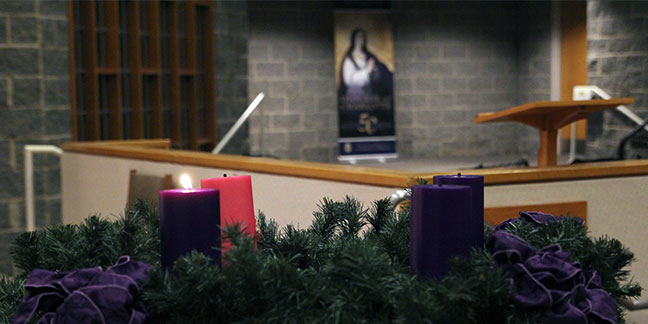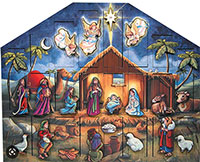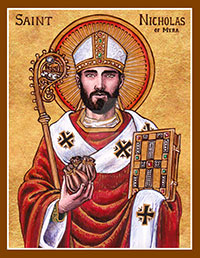 Advent, the four weeks leading up to the celebration of Our Lord’s birth on Christmas, is a time to prepare our hearts spiritually to receive our Savior. It marks the beginning of a new liturgical year in the Church and a chance for a fresh start in our prayer life as we renew our commitment to grow closer to Christ.
Advent, the four weeks leading up to the celebration of Our Lord’s birth on Christmas, is a time to prepare our hearts spiritually to receive our Savior. It marks the beginning of a new liturgical year in the Church and a chance for a fresh start in our prayer life as we renew our commitment to grow closer to Christ.
The Advent wreaths in our homes and churches – and the purple- and rose-colored vestments worn at Mass – are signs of this penitential yet hope-filled season. Our Scripture readings and hymns tell us to be alert and ready for Our Lord’s coming on Christmas.
In the final days of Advent, we sing the “O” Antiphons, pleading for God’s wisdom and light to deliver us from darkness and sin. God willing, we will rejoice with all the angels and saints of heaven on that glorious Christmas morn.
— SueAnn Howell
5 Advent Fun Facts
1. What are we waiting for? Advent is a time of expectation and preparation for the birth of the Lord. The word “Advent” derives from the Latin word “adventus,” which means “coming,” and is associated with the four weeks of preparation for Christmas.
2. Happy Catholic New Year! Advent marks the beginning of the liturgical year, also called the church year or Christian year. It starts the cycle of liturgical seasons that determine when feast days and celebrations of saints are to be observed, as well as which portions of Scripture are to be read. Advent represents the time in history when Christ was not yet known to us. The liturgical year ends with the feast of Christ the King, His reign over the universe.
3. Changing dates. Advent has a different start date from year to year, but it always contains four Sundays and ends on Christmas Eve. It begins on the Sunday closest to the feast of St. Andrew the Apostle (Nov. 30). It can start as early as Nov. 27 or as late as Dec. 3.
4. Hold on to hope! Hope is a predominant theme of Advent. The Israelites hoped for a Messiah to come, and Christ entered the world. We are hopeful for the arrival of Christ again into the world.
5. Let there be light! Advent focuses on light as opposed to darkness. Christ enters our dark world and casts away the darkness of sin to redeem us. He will come again as the light of the world.
— SueAnn Howell. Catholic Apostolate Center contributed.
‘Beloved, now is the acceptable time spoken of by the Spirit, the day of salvation, peace and reconciliation: the great season of Advent. This is the time eagerly awaited by the patriarchs and prophets, the time that holy Simeon rejoiced to see. This is the season that the Church has always celebrated with special solemnity. We too should always observe it with faith and love, offering praise and thanksgiving to the Father for the mercy and love He has shown us in this mystery.’
— St. Charles Borromeo
What is Gaudete Sunday?
For much of the Church’s history, Third Sunday of Advent has had a special name: Gaudete Sunday. The word “Gaudete” is Latin for “Rejoice.”
The traditions surrounding Gaudete Sunday go back as far as the fourth or fifth century, as does the season of Advent itself, which was originally a 40-day penitential season like Lent. In fact, because it used to begin on Nov. 12 (just after the Memorial of St. Martin of Tours), it was called “St. Martin’s Lent.” Gaudete Sunday marks the mid-point in Advent, much as Laetare Sunday does in the season of Lent.
On Gaudete Sunday, the season of Advent shifts its focus. For the first two weeks of Advent, the focus is “The Lord is coming.” But beginning with Gaudete Sunday, the focus changes to “The Lord is near.”
This shift is marked by a lighter mood and a heightened sense of joyous anticipation. Liturgically, the colors lighten as well. The priest usually wears rose-colored vestments, a hue seen only on Gaudete Sunday and Laetare Sunday. We light the third candle of the Advent wreath, which is also rose-colored or, some may say, pink.
This celebration is a reminder that the God who loves us is still in charge and that we await His coming not with fear, but with tremendous joy. This day’s second reading at Mass, from the First Letter of St. Paul to the Thessalonians, reflects this joy: “Brothers and sisters: Rejoice always. Pray without ceasing. In all circumstances give thanks, for this is the will of God for you in Christ Jesus.”
— USCCB
Prayers of Advent
The Great “O”Antiphons are brief prayers that are chanted or sung from Dec. 17 to 23. The origin of these prayers is not certain, but it is probable that they were composed in the seventh or eighth centuries when the monks put together texts from the Old Testament. The Church in Rome and the monastic communities throughout Western Europe chanted the “O” Antiphons during Evening Prayer, also known as Vespers.
Each antiphon begins with the acclamation “O” followed by a different title for the Messiah. In the Middle Ages it was traditional to ring the great bells of the church each evening as the “O” Antiphons were sung.
Today, in the Liturgy of the Hours, the “Magnificat” is preceded by one of the “O” Antiphons that links the prayer to the feast of the day or season of the year. In the last seven days of Advent, the antiphons are very special. Each begins with the acclamation “O” and ends with a plea for the Messiah to come. As Christmas approaches, the cry becomes increasingly urgent.
Saying the “O” Antiphons as a family – during grace at meals, in front of the manger scene or the Christmas tree – is a wonderful Advent devotion and a time to read, meditate and reflect on the Scriptural texts which form the basis for the “O” Antiphons.
- Dec. 17 – O Sapientia: “O Wisdom you come forth from the mouth of the Most High. You fill the universe and hold all things together in a strong yet gentle manner. O come to teach us the way of truth.”
- Dec. 18 – O Adonai: “O Adonai and leader of Israel, you appeared to Moses in the burning bush and you gave him the Law on Sinai. O come and save us with your mighty power.”
- Dec. 19 – Radix Jesse: “O Stock of Jesse, you stand as a signal for the nations; kings fall silent before you whom the peoples acclaim. O come to deliver us, and do not delay.”
- Dec. 20 – O Clavis David: “O Key of David and scepter of Israel, what you open no one else can close again; what you close no one can open. O come to lead the captive from prison; free those who sit in darkness and in the shadow of death.”
- Dec. 21 – O Oriens: “O Rising Sun, you are the splendor of eternal light and the sun of justice. O come and enlighten those who sit in darkness and in the shadow of death.”
- Dec. 22 – O Rex Gentium: “O King whom all the peoples desire, you are the cornerstone which makes all one. O come and save man whom you made from clay.”
- Dec. 23 – O Emmanuel: “O Emmanuel, you are our king and judge, the One whom the peoples await and their Savior. O come and save us, Lord, our God.”
— The Crossroads Initiative: A Ministry of Dr. Marcellino D’Ambrosio, online at www.crossroadsinitiative.com.
Saints of Advent
The Church recognizes dozens of saints during the season of Advent. Here is just a sampling of the holy men and women we remember during this season:
- Nov. 30 — St. Andrew the Apostle (early 1st century-mid/late 1st century) Brother of St. Peter, one of the 12 apostles, martyred by crucifixion. He is the patron of fisherman and singers.
- Dec. 3 — St. Francis Xavier (1506-1552) Co-founder of the Society of Jesus, patron of Catholic missions, African missions, China, missionaries and more.
- Dec. 4 — St. Barbara (Born mid-third century) Locked up in a tower by her father, she secretly became a Christian, was tortured and eventually killed by him for her faith. She is patron of armorers, artillerymen, architects, mathematicians and miners.
- Dec. 6 — St. Nicholas (270-343) Bishop of Myra, known for his generosity. In some parts of the world children put out their shoes the night before his feast day to receive little gifts. He is patron of children, sailors, fishermen and unmarried people – just to name a few.

- Dec. 7 — St. Ambrose (340-397) Bishop of Milan, one of four original Doctors of the Church, instructed St. Augustine and fought against Arianism. He is patron of Milan and beekeepers.
- Dec. 9 — St. Juan Diego (1474-1548) A native of Mexico, converted to Catholicism, saw apparitions of the Blessed Virgin Mary. He is patron of indigenous people.
- Dec. 12 — Our Lady of Guadalupe (1531) The Blessed Virgin Mary appeared to Juan Diego Dec. 9 on Tepeyac Hill in Mexico, asking for a temple to be built. To convince the bishop, she left visible signs – her image on Juan Diego’s tilma filled with fresh roses, which never bloom in December. Millions converted to Catholicism after her apparition. She is patron of the Americas and the unborn.
- Dec. 13 — St. Lucy (283-304) Virgin martyr of Syracuse, Italy, whose eyes were gouged out. She is patron of the blind and those with eye illnesses.
- n Dec. 14 — St. John of the Cross (1542-1591) Priest and co-reformer of the Discalced Carmelite Order. He is patron of contemplatives, mystics and Spanish poets.
- n Dec. 23 — St. John Cantius (1390-1473) A professor with a doctorate in both philosophy and theology, known for his generosity and care for the poor, especially students. He is patron of Poland and Lithuania.
Visit www.catholic.org/saints to learn about a new saint each day during Advent.
— SueAnn Howell. Catholic Online and Wikipedia contributed.
Blessing of a Christmas Nativity Scene or Manger
The custom of displaying figures depicting the birth of Jesus Christ owes its origin to St. Francis of Assisi, who made the first Christmas crèche or manger for Christmas Eve of 1223.
The blessing of the Christmas manger or nativity scene may take place on Christmas Eve or other suitable time. When the manger is set up in the home, it is appropriate that it be blessed by a parent or another family member. Here is a blessing:
All make the sign of the cross.
Leader: Our help is in the name of the Lord.
Response: Who made heaven and earth.
Leader: (or other participant) reads a text of sacred Scripture, for example, Luke 2:1-8 or Isaiah 7:10-15.
Reader: The Gospel of the Lord.
Response: Praise to you, Lord Jesus Christ.
Join hands for prayer.
Leader:
God of every nation and people, from the very beginning of creation You have made manifest Your love.
When our need for a Savior was great, You sent Your Son to be born of the Virgin Mary.
To our lives He brings joy and peace, justice, mercy, and love.
Lord, bless all who look upon this manger.
May it remind us of the humble birth of Jesus, and raise our thoughts to Him, Who is God-with-us and Savior of all, and Who lives and reigns forever and ever.
Response: Amen.
— USCCB
What is an Advent calendar?
 The Advent calendar is believed to have been created by Christians in the early 19th century to mark the days of Advent leading up to Christmas. It counts down the 24 days of Advent beginning on Dec. 1 and ending on Christmas day. The first known Advent calendar was handmade in Germany in 1851.
The Advent calendar is believed to have been created by Christians in the early 19th century to mark the days of Advent leading up to Christmas. It counts down the 24 days of Advent beginning on Dec. 1 and ending on Christmas day. The first known Advent calendar was handmade in Germany in 1851.
Many Advent calendars are made of paper or wood and display a colorful nativity scene with little numbered windows or doors that open to reveal a symbol of Advent or Christmas, or a passage from the Bible relevant to the Christmas season. Some special Advent calendars even have chocolates or other treasures hidden behind each flap or door.
Children especially enjoy opening the flap or door of the Advent calendar to see what treat awaits them each day.



